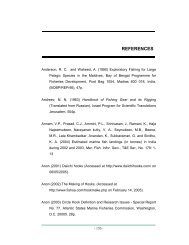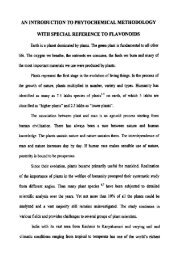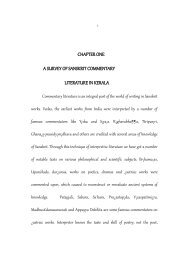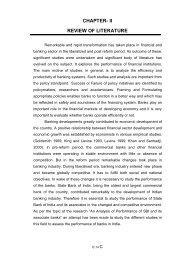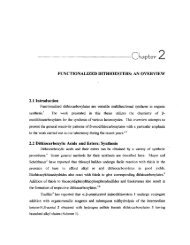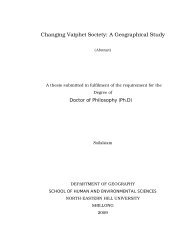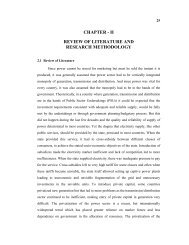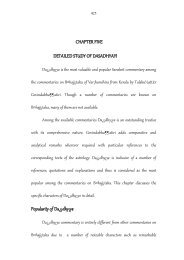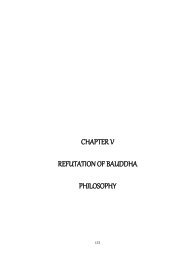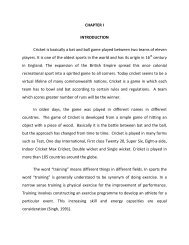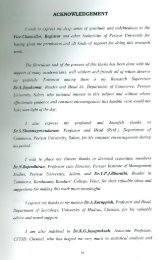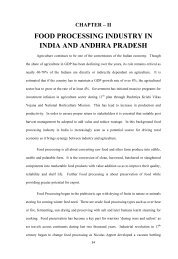CHAPTER-5 JOINT FOREST MANAGEMENT: STUDY OF A VANA ...
CHAPTER-5 JOINT FOREST MANAGEMENT: STUDY OF A VANA ...
CHAPTER-5 JOINT FOREST MANAGEMENT: STUDY OF A VANA ...
You also want an ePaper? Increase the reach of your titles
YUMPU automatically turns print PDFs into web optimized ePapers that Google loves.
<strong>CHAPTER</strong>-5<strong>JOINT</strong> <strong>FOREST</strong> <strong>MANAGEMENT</strong>: <strong>STUDY</strong> <strong>OF</strong> A <strong>VANA</strong> SAMRAKSHANASAMITHI5.0 IntroductionWhat emerges from the preceding chapters is that the State agencies exertedgreater control over forests and brought about increasing commercial interests on forestresources, throughout India, rural especially tribal habitations which had used these landsto meet basic needs, experienced loss of their rights on forest resources. Employmentopportunities in collection of minor forest produce, forest works as well as in agricultureare unable to support the tribals throughout the year. This led on the one hand to theworsening of the state of forests and on the other in growing hardships inflicted upon thetribals even for meeting their subsistence needs. In several regions, local peoplechallenged the right of the state officials to interfere with their forests and launched massagitations for protecting local forests (Dolly Arora, 1994). This resulted in the emergenceof two types of institutions in tribal areas. One was that the State changed its policy bypromoting local people's participation in forest conservation. To involve the people in theforest conservation, State introduced Joint Forest Management. The other was theinvolvement of the Non-Governmental Organisations (NGOs) in motivating andorganizing the tribals to assert their rights.This chapter is an attempt to study the JFM and functioning of the VanaSamrakshana Samithies (VSSs) in Rampa Country. The chapter consists of four sections.The first section deals with JFM in general and the experience of West Bengal inparticular. The second section is on JFM in Andhra Pradesh, the third section is anattempt to study of functioning of Gandhi Nagaram VSS, and the last section consists ofconclusions on the role of JFM.5.1. <strong>JOINT</strong> <strong>FOREST</strong> <strong>MANAGEMENT</strong> (JFM)Lately, there has been recognition about the rights of the local people, especially,the tribals and the need to involve them as partners in the protection and management of
148forests. The National Forest Policy of 1988 envisages people's involvement in thedevelopment and protection of forests. The requirement of fuel wood, fodder and smalltimber such as house-building material, of the tribals and other villagers living in andnear the forests, are to be treated as first charge on forest produce. The policy documentenvisages it as one of the essentials of forest management that the forest communitiesshould be motivated to identify themselves with the development and protection offorests from which they derive benefits. Government of India has requested all the stategovernments to involve committed NGOs for motivating and organising villagecommunities for protection, afforestation and development of degraded forestland,especially in the vicinity of habitation and issued guidelines to all stategovernments(letter No.6-21/89-F.P. Dt. 1-6-1990).Government of India proposed that access to forest land and usufruct benefitsshould be provided to those who got organised into a village institution such aspanchayat, cooperative of the village or village forest protection committee, specificallyfor forest regeneration and protection. The Forest Department however was to closelysupervise the work and usufruct benefits could be withdrawn if it was not satisfied withthe protection work. Although the exact nature of the agreement between the State andthe village institutions is not the same in all the states, it is ensured that the benefits goesto those who are involved in the process of protection of the forest.By the central government GO, nearly 16 states including Andhra Pradesh, whichhave 18.43 per cent of the country's forests and 91.6 per cent of the country's tribalpopulation, have facilitated the implementation of this policy in their respective territoriesby issuing enabled orders providing details of the arrangements. The nature of theagreements arrived at, in various states have not been the same. There are importantdifferences between the states regarding the extent of power retained by the ForestDepartment and those delegated to the people(Table 5.1).
TABLE: 5.1 SALIENT FEATURES <strong>OF</strong> JFM RESOLUTIONS149STATEORISSAWESTBENGALBIHARGUJARATRAJASTHANM.PTRIPURAMAHARASHTRAJ*KHARYANAPDale of issue ofresolution14 IMS127S91 119013 3 9116 3 9110.12.9120 12 9116 3 9219 3 92136902«»»2Fores. CategoryDFSensitive to damageD F and barren forestsDemarcided prrtectedD F, DPAP areas ofRFDF(PROTECTED)DFDF•ndDFDFDF*RFwatershedAdjoiningEconomicallyon, person formperson, interestedwilling villagerswilling villagersfamilies with a, le«tpenchavaiA FPCone person from eacheither actual users orParticipantsvillagersbackward peopleeach familyin forest devone wage earnerconsiringof.il villager,family of adjoiningright holdersadjoining villagesvillagesnatural reg ?00hahamlet or village orvillage less thanManage—meritone forestforest beatvillagevillagemax 50 havillageplantation 300 hanot definednotdefinedpmchaytt (min 10-15500m normally deepunitcompartmenthhj)Executive3 or leaf forester6 or leasdependent on torn.5 or more, ranger.Committee«rpanch,berbeat officervanpal.min 2 women anyaccording to statekotwar. teacher.5orten.be*6
150All the resolutions of different states have provided usufruct rights to user groupsand clearly noted that land is not to be allocated or leased. The tenurial period for usufructrights is not mentioned in most of resolutions and the rights are confined to only degradedforests. Village-level groups are to operate under the supervision of Forest DepartmentOfficials as the resolutions recommended village-level committees as functionalmanagement groups. Some resolutions proposed the formulation of joint management plansto coordinate the agency and community activities(Poffenberger et.al. 1996). However,operational guidelines for cooperative planning are unclear, and where they are outlined,they tend to reflect the interests and concerns of the forest department.The notifications state governments had given usufruct rights only to the user group.Land is not allotted or leased to any one. All the State Governments adopted orrecommended village level committee as functional group which has to operate through (orby) Forest Department Officials. According to one estimate, by mid-1992, more than 1.5million hectares of forest land which is about two per cent of India's forest area, is alreadybeing protected by more than 10,000 community institutions in 10 states(Singh and Khare1993).The involvement of people in forest management is started in some states like WestBengal much before 1988. Since 1970-71 the West Bengal Forest Department has beeninvolving the people in forest protection and regeneration which demonstrated that if therights are given to the communities they would effectively protect the forests. The nextsection is an attempt to understand the functioning of Forest Protection Committees(FPC)of West Bengal.5.1.2. Forest Protection Committees (FPC): An Experience of West Bengal:The FPC programme began 1 in 1971-72 at Arabari Research Station, which covers1 Since the inhabitants of Arabari forest area are depended much on forest, the then DFO realised that it wasdifficult to regenerate and protect. DFO contacted the forest villages and discussed the problem and graduallyestablished rapport and analysed the problem. As there was no employment opportunities to the landlesslabourers especially in the lean period, they exploit the forests to generate cash. DFO promised to help themto solve their problem in lean period provided, they cooperate with him. With the assurance of the localpeople, DFO demarcated 1272 hectares of wasteland to be covered under plantation scheme and asked themto form a committee(Malhotra, K.C. et.al. 1989).
151an area of 1,272 hectares. The FPC incorporates 11 villages surrounding the project areawith 618 households. Though the Committee was formed in 1972, it was formalized in1977. All the 618 households were included as members of the Committee. The presidentfollowed by the secretary and council members belonged to each member village and headedthe committee. When the committee started functioning, a man and a woman from eachmember village guarded the forest every day. Each member was assigned a patrol duty forone week in every two months. If a person who is not a member of the committee is spotteddestroying or cutting the wood from the forest, he is caught and fined or handed over toForest Department. If a member of the committee is at fault, committee listens to hisproblems and assures him of work within the villages, only if he promises to stop cutting theforest.To gain community cooperation in protecting the forests, the forest departmentcreated employment opportunities and offered MFP by giving usufruct rights. Sal poles wereprovided to the villagers at subsidized rates and 25 per cent share of income from the polesand firewood. And also they were given exclusive rights on all minor products. Theseincluded dry leaves and twings, sal and tendu leaves, fruits like mango, guava, jack, bale,tendu. Over the past decade the West Bengal Forest Department has developed a programmewith currently over 1,250 forest villages in Southwest Bengal have regenerated 152,000hectares of natural sal forests. The forest communities are encouraged to form FPCs, toguard against unauthorized cutting and grazing. The rapidly coppicing sal and companionspecies generate numerous MFP to which members have exclusive rights(Malhotra, et.al,1989).Malhotra and Poffenberger( 1989) estimated the benefits to the members of FPC inPukuria village of south Bankura district and observed that the rapid regeneration of forestyielded substantial income from minor forest produce to the villagers. In the village, 93households belonging to Santal tribal community are formed as FPC in 1982 and decidedto protect an area of 130 hectares. The study shows that the income generated from all minorforest produce indicates that a woman could able earn about Rs.2500 to Rs.3500, which
152comes around Rs.7 to Rs.10 per day from one hectare. In the village, women collect of salleaves and make, which provides employment for a period of four months in a year and theycould earn nearly Rs.1040. Other important activities by which members of FPC are thecollection of bidi leaves and sal seeds. Annually, a household will get around Rs. 1000 andRs.92 respectively for the activities mentioned above(Table 5.2). Hence MFP collectionrepresents the primary occupation and is the major source of income for women of thevillage. The regeneration of sal forests is combined with the benefit of protecting upper ridgetracts where the forest is located, and this system seems to have potential to generateemployment and income.TABLE: 5.2. INCOME GENERATED FROM SAL <strong>FOREST</strong>S <strong>OF</strong> PUKURIA FPC.ProductSal poles andfire woodSal seedsTasar cocoonsSal leaf platesBidileavesQuantity per Ha. orFamily400 poles, 25m3firewood per Ha. (10years rotation)77 kgs per Ha.(April)Up to 1280 perfamily (Aug-Sep/Dec-Jan)65000 per family (4months/year)10,000 per day perfamily( April-May)Annual Incomeper household*Rs.500 per ha.Rs.92 per ha.Rs.640Rs.1040Rs. 10,000TOTALRs.3272* These estimates assume an average of one Ha. of produce per Household.Source: Malhotra, et.al., 1989.Over a decade of experience made the West Bengal forest department to concentrateon equity issues. They identified two issues, one is sharing of the benefits among themembers. The landless and tribals with low income are dependent more on forests for theirsurvival. When the forests were closed to regenerate, it is these communities who suffer withdecrease of income. The West Bengal Forest Department has attempted to respond to thisneed by creating employment for these communities. At the time of harvesting of sal poles,
153there is a need to develop procedures to ensure that the benefits are not captured by villageelites. And other issue is the inter-village distribution on which Forest Department iscurrently focusing. The area of forest under each committee varies. Some communities nowmanage over 500 hectares, while others have less than 20 hectares available for use. TheForest Department is attempting to enhance equity by consolidating small FPCs into largergroups, so that total forest income can be divided equally(Poffenberger 1990). So, the WestBengal Forest Department has pioneered a new approach to regenerate degraded foreststhrough community participation.With this background, the next section is an attempt to study the JFM in AndhraPradesh. The VSS, which we have considered for the study has an experience of only twoyears. Hence we concentrated on the nature of involvement of people in decision making aswell as implementation of VSS activities and employment generated by JFM in thatparticular village.5.2. <strong>JOINT</strong> <strong>FOREST</strong> <strong>MANAGEMENT</strong> IN ANDHRA PRADESHGovernment of Andhra Pradesh issued an order on JFM in 1992, becoming theeleventh state to do so, naming the forest protection committees as Vana SamrakshnaSamithies(VSSs) for the protection and regeneration of forests(G.O.Ms. No.218, EnergyForests Environment Science and Technology For.VI-I dated 28.8.1992) 2 .Process of forming VSS in a village start with building of rapport with villagers bythe forest officials and communicating the concept of JFM. Villagers are informed of theopportunities and limitations, and also the long and short-term benefits of the programme 3 .In order to form the VSS at least 50per cent of the households should have to agree to2 The GO was subsequently modified in November 1993 (GOMs No.224) and several new sectoral reformswere adopted in the same month (GOMs No.237, 1993).3 Explanation of the procedures involved- in the management of the VSS, roles and responsibilities of thecommittee, operation of the bank account, maintenance of the minutes book and management practices andmake the people to involve in the preparation of Micro Plan.
154become members, there should be one female and one male member from each householdas members and the managing committee should consist of 15 elected members (GO No.221dt.l 1.11.1993). And other members are concerned Forest Guard, an officer nominated byITDA, and a local NGO. The Village Administrative Officer is an ex-officio member andconcerned Deputy Range Officer is the member secretary. Managing committee will meetat least once in every month. The Member-Secretary shall be responsible for convening themeetings and to maintain the records of the proceedings. A copy of the record ofproceedings shall be sent to the Forest Range Officer for information and advice. In case,he finds that deliberations of the Managing Committee are contrary to the JFM plan orrelevant forest acts and rules he shall report the matter to higher officialsimmediately(G.O.Ms. No.218, Energy Forests Environment Science and Technology(For.VI-I dated 28.8.1992). This indicates that the Managing Committee is closelysupervised and controlled by the department.Forest area up to 500 meters interior from the R.F. boundary will be allotted to theVSS 4 . Members of village level committee are entitled to share all non-timber forestproduce except those for which GCC holds the monopoly rights. However the right tocollect non-timber forest produce shall remain with the members. In case of tendu leaf 50per cent of the net income from increased yield over and above the average yield of fiveyears (in weight) due to better protection and management offered by the VSS will be paidto VSS members equally. And the village level committee shall be entitled to 100 per centshare in net income of timber and bamboo harvested from the regenerated degraded forestsas prescribed in the approved Micro Plan.In Andhra Pradesh by the end of 1997 nearly 1665 VSS are formed with totalmembers of 3.95 lakhs by covering nearly 4,92,209 hectares of area. As a whole 47 per centmembers are female. Female membership is comparatively higher in Hyderabad andNizamabad VSS(Table 5.3) This was under the Andhra Pradesh Forestry Development4 This restriction is being withdrawn in the proposed amendment and it will be based on the traditional useof the forest area and capacity of the villagers to protect(G.O.Ms.224 of 1993).
155Project, assisted by World Bank, which lays emphasis on people's participation in planning,protection and management of forest resources through JFM. After a review of theconditions of the state's forest, Chief Minister of Andhra Pradesh convened a meeting todiscuss the JFM Programme and emphasised the need to take up a massive programme forafforestation of the state's degraded forest. It was decided to rehabilitate of 400000 hectaresof degraded forests through VSSs during 1996-97 and further 14,00,000 hectares over athree year period. This programme, (which would not come under Andhra Pradesh ForestryProject of Wold Bank) was re-named as Vana Samarakshana Udyamam, and latercommonly referred as CM-JFM. The Forest Department has identified some 8200 fringeforest villages as being suitable for the formation of VSSs under the programme.TABLE: 5.3. CIRCLE WISE NO.<strong>OF</strong> VSS FORMED BY 1997 UNDER APFDPNo.ofMembersArea AreaCircleVSSAllotted Coveredformed Male Female Total (Ha) (Ha)AdilabadAnantapurGunturHyderabadKhammamKumoolNizamabadRajahmundryVisakhapatnamWarangalTOTAL34011712414219399204572141751665194541135111184245771553464394300248421351559548209446(53.0)17151106979571276091215651184075637611172047162185701(47.0)36605220482075552186276901155783758860325235106710395147(100)13034835213300254107545904272656068819279403866202649220930432108256104969414538193111223165592195014697146341Source: GOAP(1997): AP Forestry Project: Status Note, Forest Department.Adilabad circle recorded more number of VSS(340) by covering nearly 1,30,348hectares and this was followed by Nizamabad and Visakhapatnam circles. Among the totalallotted area to VSSs(4,92,209 hectares), 146341 hectares (29.7 per cent) are covered. As
156NGOs 5 participation as concerned nearly 174 NGOs are involved in 554(33.3 per cent)VSSin all circles. Table 5.4 shows that there was no involvement of NGOs in the circle wheremore VSSs are formed.TABLE:5.4. CIRCLE WISE NO.<strong>OF</strong> NGOs INVOLVED IN VSSCircleVSS with NGOs involvementNo.ofNGOsinvolved No.ofVSS % to total VSSAdilabadAnantapurGunturHyderabadKhammamKumoolNizamabadRajahmundryVisakhapatnamWarangalTOTAL--32124234810452176-7626514585-2617615554-65.021.03.575.185.6-45.682.28.633.3Source: GOAP(1997): AP Forestry Project: Status Note, Forest Department.Though it is too early to evaluate the VSSs in Andhra Pradesh, one can see variousinstitutional structures that have emerged during the process of implementation, like theprotection of forests, and capacity building among the members especially in marketing andthe issues that have generated conflicts.5.2.1. VSSs in Forest ProtectionActivities like smuggling of timber and wood for commercial as well as domesticuse and grazing of cattle, especially goats, are primary threats to the forest regeneration. To5 As per the G.O. Ms 224 of 1993, NGO are considered as special invitees in VSS committee and it waschanged as members of VSS committee without voting nght. NGOs are playing supportive role in assistingthe Forest Department and communities to develop joint participatory management programmes and providingtraining, research and assisting in community organisation and field monitoring. As observed by Barathi, etal.,(1998) NGOs involved in JFM of Andhra Pradesh were small local groups, with lunited area of operations andsmall funding.
157prevent these activities different VSSs in Andhra Pradesh have evolved their own methodsof protection. These systems may be grouped into three types i.e., i. Watch and ward system,ii. Rotation system, and iii. Check-post system.i). Certain VSSs are employing a person to watch and ward the area, who will bepaid for his services. Even within this system there were different of arrangements ofpayment to guards. The case of Cheedipalem shows the VSS paying salary to guard fromthe VSS fund. Cheedipalem is a village of Vijayanagaram district in which VSS has formedin 1994. Forest Department has allotted an area of 250 hectares for JFM activities on a hillcalled Gantikonda. The surrounding villages also depended on the hill for their timberrequirements. As the extent of pressure on forests of the area is high, the VSS has decidedto restrict their protection to the earmarked area. The committee has employed a person onfull time basis to watch and ward the forests of allotted area and paid Rs.500 per month fromthe VSS funds.In some cases, instead of paying guard's salary from the VSS funds, committee iscollecting a fixed amount from each member household towards the salary of the guard.Rachapalli, a village in Makavaripalem mandal of Visakhapatnam district, is a good examplefor this system. In the village, VSS was formed in 1996 by the initiation of the youth whoread about the programme in the newspapers. Area was allotted in Panduru forest block onwhich four neighbouring villages also depended for their requirements. Since some of thesevillages also have formed VSS, the pressure on the forests was declined. To protect theallotted area the committee has employed a person to watch and ward by paying Rs.600 permonth. Each member household is contributing Rs.5 towards the payment of guard's salaryas decided in general body meeting.ii). Another method, which is prevailing in some of the VSSs, is rotation system. Thecommittee will entrust the responsibility of watch and ward to 4-5 members each day onrotation. This method of protection can be seen where the pressure on the forests is veryhigh. One of the examples for this system is Dandipadu village. Dandipadu- a village in
158Buttayagudem mandal of West Godavari district, which is located on the main road betweenButtayagudem and Kannapruram, consists of 33 households belonging to Konda Reddytribe. The villagers are not involved in smuggling of timber but they depended on the forestsfor firewood, timber for agricultural implements and collection of MFP. But the forest ofthis village is known for timber smuggling by the neighbouring villagers. In 1995 VSS wasformed by the initiation of a local NGO called Sri Agency Seva Sangam(SASS). Thecommittee has identified that the area should be protected from smuggling, grazing, forestfires and encroachments. Then VSS committee informed the neighbouring villagers aboutthe restriction on grazing in the VSS area. For the protection against smuggling thecommittee decided to watch and ward the area by 4-5 members every day on rotation.VSS of Ippapenta SC Colony has another experience in the protection of forests,where not only the outsiders but also some of the communities within the village are alsoinvolved in smuggling of timber. Ippapenta is a village in Chintakommadinne mandal ofCuddapha district. The village is located near by the Pallakonda Hill Range. People of SCColony are depended on trading of forest produces including gum, leaf, fruits, timber andfirewood. Earlier, the FD officials harassed them, while they were involved in the collectionof forest produce even for self-consumption. On the contrary, these officials were allowingthe rich farmers to collect firewood, timber, free grazing of their cattle and smugglingactivities. And here is a practice of smuggling of timber by not only the villagers but alsoby neighbouring villagers through tamed cattle without being accompanied by their masters.In this situation VSS was formed by the people of SC colony of the Village in 1995. ForestDepartment allotted 500 hectares of area for JFM activity. Initially VSS had a tough timein the protection of forest in the allotted area and VSS has started motivating smugglers andrich farmers not to enter into the allotted area. After a prolonged interaction and persuasions,the exploitation of forests was controlled. Mean time, two villagers selected daily on rotationhas been patrolling around the forest area.iii). In some cases VSS established check posts at peak smuggling points to restrictthe smuggling of timber. The experience of Juttadapalem shows VSS establishing check
159posts to prevent smuggling. Juttadapalem is a village in Devarapalli mandal ofVijayanagaram district. The village consists of people of the four displaced hamlets by theRaiwada Irrigation Projects and they occupied PWD land for cultivation. While the allhouseholds have access to land, none has any title or legal rights to the lands and unable toget any credit facilities for agriculture as well as for livestock on these lands. The mainoccupation of the villagers is agriculture and agricultural wage labour in surroundingvillages.The village comes under the Mariki reserve forests on which several villages dependfor their requirement than the Juttadapalem. Smuggling is rampant in the area. Nearly 5000carts load of firewood has been going out annually from this forest. At this situation VSSwas formed in Juttadapalem village in 1995. Since the allotted area is covered by thereservoir at one side and a hill on the other access is only possible from the village. The VSScommittee established a check post at that point. Two villagers have been appointed at thecheck post to check the neighbouring villagers from trespassing into the area. All the VSSmembers have been issued ID cards, which they have found useful in apprehendingtrespassers from adjacent villages. The VSS has collected nearly Rs.2000 by collecting fines.Cattle and sheep grazing is also restricted.5.2.2. VSS and Marketing of MFP:Since the VSS has usufruct right over the collection of MFP, some of VSS havetaken up the collection and marketing of MFP collectively. Chengicherla has an experienceof this kind.Chengicherla is a village in Ghatkesar mandal of Ranga Reddy district. Goudacommunity is a dominant caste in the village and they have large extent of lands. The othercaste groups in the village are kapu, reddy, kummari, golla, Muslim, erukala, lambadi andMadeira. Ninety per cent of households are landless. Reserve forest with forestland of259.65 hectares is 1\2 km from the main village. Since the village is nearer to Hyderabadthe forest of this area was almost disappeared. In 1994 a VSS was formed in the village with95 members, all of them are women, and later few men also joined.
160In the past, cattle grazing were rampant in the area. Panchayat fine for suchtrespassing is just Rs.2.50 per cattle per day. So the people tend to drive their cattle into theforest and escape by paying Rs.2.50. With the experience of Panchayat, now the VSS fixedthe penalty at Rs.270 per cattle to prevent the grazing. At the same time, VSS cultivatedimproved grass in a hectare plot. The whole plot was divided into parts and auctioned thegrass. The VSS got Rs.30,000 in an auction conducted in 1997.Another VSS called Nanayala VSS of Chittoor district has taken up soap nut salecollectively. VSS has formed in the village in 1995 with 221 members. The village is knownfor different varieties of MFP, i.e. tamarind, soap nut, kalikai, ullinja, neredu, nelli velaga,honey and broom grass. The collection of these different MFP is spread out throughout theyear. By the advice of Forest Department, the villagers came to a decision to collect andmarket the MFP collectively. In 1996 they have collected 14 tonnes of soap nut. With thehelp of forest department, each member household made an income ranging from Rs.1500-2500 during that season.These experiences shows that development of marketing skills and benefit sharingmechanism may create base to the members for future activity when VSS starts getting yieldout of their efforts in forest regeneration and protection.5.2.3. VSSs in Resolving the ConflictsIn the process of implementation of JFM in the state, different conflicts haveemerged between the villages(i.e. between adjacent VSS villages as well as non-VSSvillages) and also within the VSS. These conflicts can be grouped into two types on the basisof nature of the conflict. First, boundary conflicts that arise when there is an overlap ofallotted forest area traditional boundary of the villages. Gannela VSS had a conflict on theboundary of VSS area with the adjacent Dappuguda village. Gannela is a village inVisakhapatnam district consisting of 100 households. The inhabitants of the village aretribals belonging to bagata, valmiki and konda doras. In 1996 VSS was formed and theForest Department demarcated certain area. But the area comes under the adjacent village-
161Dappuguda, where the villagers are doing podu on the demarcated area. Hence the villagersof the adjacent villages opposed the activity and destroyed the plantations of VSS. Still theproblem is pending. This shows that boundary demarcation is an important aspect whileforming VSS. Sharing of the benefits and conflict resolutions with neighbouring villagerscan be avoided only if the boundaries are clear.Second, the regulatory conflicts arise due to the restriction on the use of forestresources in the allotted area of VSS. These types of conflicts emerge even within the villageof VSS. The case of Pittagud is a best example of this kind of conflict and VSS efforts tosolve the problem. Pittagud is tribal hamlet of Jainoor panchayat, a mandal headquarter ofAdilabad district. Since the village is mandal headquarters, the population of the village isa mixture of minorities, few trading communities and tribals. These are depended on theadjoining Marlawai reserve forest for their timber and firewood requirements. In 1995villagers of Pittagud formed into VSS. Since there was no other forest area near by forJainoor people, to meet their fuel wood, it caused a conflict between the VSS members andpeople of Jainoor when the VSS started patrolling the reserve forest. When VSS has caughtthree cartloads of fuel wood of Jainoor people, tension was built up. The intervention ofForest Department by booking cases increased the tension further where the villagersdecided to withdraw the VSS. At that time FD did a survey on fuel wood demand anddiscussed with the people for an alternative energy source.As per the plan, the 12 households of business community and 18 households ofemployees are shifted to kerosene and LPG, as the availability of fuel wood was difficult.Agricultural households, who have cattle, were advised to go for gobar gas plants. One plantof 2 cum. was priced at Rs.5,600 out of which the central subsidy was Rs. 2,500 and balanceof Rs.3,100 was to be bom by the beneficiary. The Forest Department was agreed to bear50 per cent i.e. Rs.1550. About 18 households came forward to take up biogas plants. Othersmall fanners and other land less with no sufficient cattle were given smokeless chullas andthey have agreed to use cotton stakes with brushwood in place of logs to meet domesticenergy needs.
162These issues of conflict raised several questions. One, can the VSSs resolve theseconflicts with present nature of functioning. Will it be able to sustain the collective naturein future while sharing the yield out of their protection measures or will it be dominated bycertain sections of people in VSS. These will be depended on the level and nature of people'sparticipation in decision as well as implementation of the activities. In this context nextsection is an attempt to study the level of people's participation in a VSS of Rampa region.5.3. A JFM VILLAGE: <strong>STUDY</strong> <strong>OF</strong> BAPANAMMA <strong>VANA</strong> SAMRAKSHANASAMITHI:5.3.1. Background of the Village:For the purpose of a detailed analysis of the functioning of the VSS in the study area,a village, Gandhinagaram was selected. Gandhinagaram is a tribal hamlet, located three kms.away from the mandal head quarters, Rampachodavaram of East Godavari district, AndhraPradesh. A stream separates the village into two streets, called old and new streets.Gandhinagaram is a heterogeneous village consisting certain tribal communities as well aspeople from plains belonging to certain castes. The village consists of 88 households ofthree tribal communities and two caste groups. In the hamlet 88.6 per cent of householdsbelong to Koya Dora community and others are Konda Reddy (2 households), KondaKammara (4 households) Mala - a Scheduled Caste group (2 households) and Kamma (2households) (Table. 5.4). Koya Doras are the original settlers of the hamlet and others areimmigrants during the last 40 years.A non-tribal household belongs to Reddy community from the plains and thishousehold is involved in several activities ranging from petty business, arrack selling totimber. This is the first external intervention into the hamlet other than state intervention,which has initiated number of changes in the socio-economic relations of the tribes of thehamlet. As reported by the villagers, one can observe that, though the reddy community isa cultivating caste group in the plain areas this household did not involve in agriculturaloperations. And they used to give credit by tying with several forest produce collected bythe tribals.
163At that time, all the property of land and trees like tamarind, mango, soapnut andtoddy within the village boundary were under community ownership. As stated by avillager, the atmosphere within the village community was intensely democratic. Eachmember has equal rights under the leadership of the hereditary head (Kulam pedda/head ofthe village) of the village. As we observed in chapter II, the village head enjoys no privilegesand exercises no authority over his fellow villagers; he presides over Tanchayat' but hisdecisions must be endorsed by the opinion of the community as in other tribal villages. Thevillage council itself resolves the disputes among the villagers. The village council is notan exclusive body but an informal gathering of all the householders. When an aggrievedparty lodges a complaint with the headman, he summons the villagers for discussion of thematter. The village council was the center for their organisation.Until before mid 1970s all households in the hamlet practiced podu cultivation,while presently only 25 households (28.4 per cent) are involved in podu cultivation. Thecrops grown on podu field are jowar, bajra, redgram and soma. Besides this podu, tribes ofthe hamlet collect edible and non- edible forest products for their subsistence. The peopleof the village collect various varieties of minor forest produce like honey, beeswax,soapnuts, tamarind and tendu leaves. Government issued individual pattas in mid 1970's thathappened to be the major intervention of the state. As we observed in the earlier chapters,the importance of traditional institutions has also started to decline in the village after thereservation of surrounding forests during late 1960's and also land settlement operation of1974 which gave scope for outsiders to enter into the forest area.Among the 88 households, 9 households (10.2per cent) are landless. 16 households(18.2per cent) owned above 10 acres of land by owning 249 acres of land with an averageof 15.6acres and nearly 23 households (26.1per cent) owned between four to six acres with104.5 acres which comes an average of 4.5 acres. As a whole nearly 53.4 per centhouseholds owned 30.8 per cent of land while remaining 36.4 households owned nearly 69.2per cent of land(Table 5.5).
164The crops grown on apt lands are cashew, paddy, bajra, jowar and redgram. Cashewwas introduced by ITDA in the village under IF AD in which nearly 70 per cent ofhouseholds are involved. But most of them are leasing-out the produce every year tonon-tribals of the plain areas as prevailed in whole of the agency area. Rent ranges fromRs.2000 to Rs.5000 per acre per annum while the non-tribal getting nearly Rs.50,000 toRs.80,000 per acre of cashew produce. Only five households are carrying out cashewmarketing by themselves. As far as the other crops are concerned few households arecultivating on patta lands. Others nearly 15 households are leasing-out their lands to thenon-tribals of the adjacent town, Rampa Chodavaram. The rent ranging from Rs.1000 toRs.1500 per acre per year. So only 32 per cent of households are cultivating jowar, 20 percent households cultivating bajra and 22 per cent households are producing paddy in thehamlet. One can observe that even though 'plough' cultivation was prevailing in the village,most of the villagers are selling the animal manure to the cultivators of the plain areas.Tribals of the village are depended on the trader cum moneylenders of Rampa Chodavaramnot only for selling their produce but also obtaining credit.Since the village is adjacent to the mandal headquarters, the village became one ofthe centers for forest contractors to get labourers for forest operations. Till 1980 most of thehouseholds are involved in forest operations in the Rampa region as labourers. Presently,nearly 25 households are involved in the forest works and most of them are womenlabourers. Since Rampa Chodavaram is the center for the government administration, all thegovernment agencies are located in this town. This made the town as a business center andcreated more demand for timber and non-timber forest produce of the surrounding forestarea. This brought changes in the economic activities of the tribals of the village. Presentlycollection and selling of firewood is the major activities of the tribes of the village by whichthey earn nearly Rs.250 per week. Presently 45.5 per cent of households are depended onthis activity for their cash requirements. Interestingly, the selling of fire woods alsointroduced by a non-tribal in 1970's to the villagers, who cuts and sells fire wood.
165The reservation of surrounding forests and state management system of forests andthe establishment of government agencies resulted in the entry of non tribal population intothe area as forest contractors as well as employees and petty traders and made the tribals toenter into market relations. The alien systems destroyed the traditional subsistentinstitutions. The villagers are totally depended on forest works as labourers, collection offirewood and the traders/money lenders. Presently the hamlet is known for the conflictsamong the tribals and also for prostitution. At this juncture, forest department with the helpof local NGO introduced JFM activities in 1995 and formed VSS.5.3.2 Members of the VSSThe VSS was formed with seventy-five per cent(66) of the households in the village.Nearly two members from each household (mostly wife and husband) are the members ofVSS which comes around to a total of 139 members. Since Koya Dora is the dominantcommunity in the village, 73.1 per cent of that particular tribal household became themembers of the VSS. Among the member households 64.8 per cent belong to Koya tribe.All the households of remaining tribes also joined as the members. One household ofKamma of plain area is also a member and remaining one household of same caste did notjoin because he is an employee in ITDA(Table 5.5). Among the non-members sevenhouseholds owned more than 10 acres of land each while eight households owned between6-10 acres of land. Two households did not join as the members because they are employees.The non-members who have more than eight acres of land are busy with their ownagricultural operations and they expressed that JFM is not useful to them in any way. Otherhouseholds expressed that they did not know about the formation of V.S.S. in their villageand some of them express that they want to keep themselves away from the forestdepartment because of their bitter experiences with the forest department when they wereselling fire wood. It indicates the failure of the forest department in creating awareness onthe JFM and its nature and importance before formation of the VSS.When it comes to the members in terms of land holdings, 10.6 per cent (7) memberhouseholds are landless. The others are 7.6 per cent households owned less than 2 acres of
166land, 25.8 per cent (17) householders owned between 2-4 acres of land, 30.3 per cent (20)households with 4-6 acres, 9.1 per cent (6) households owned between 6-8 acres and 16.6per cent (11) households owned above 8 acres of land. Table 5.6 shows that among the totallandless households nearly 77.8 per cent joined as members and 89.5 percent among thehouseholds who owns 2-4 acres of land became the members of the VSS, while 40 per centamong the households whose landholding are between 8-10 acres have joined(Table 5.6).This shows that the households who have smallholdings became the part of VSS becauseof their dependency on forest resources mainly in collection of MFP and selling of firewoodand for employment.TABLE: 5.5. TRIBE WISE NUMBER <strong>OF</strong> MEMBER HOUSEHOLDS <strong>OF</strong> GANDHINAGARAM VSSMemberHouseholdsNon-memberHHsTOTALKoyaDoraSource: Field. Study57(73.1)21(26.9)78(100)KondaReddy2(100)-2(100)KondaKammara4(100)-4(100)Mala(s.c.)2(100)-2(100)Kamma(o.c)1(50.0)1(50.0)2(100)TOTAL66(75.0)22(25.0)88(100)5.3.3. Location of JFM:The area demarcated for the VSS is located in between Rampa Chodavaram andGandhinagaram. The area comes under Geddada beat, which comes under the jurisdictionof Rampa Chodavaram range, and lies between 17"-25' and 17"-27' latitude and 81 "-42' and81 "-47 longitude of notified scheduled area. One can observe that the area is very nearer toRampachodavaram(0.3 kms.) than the JFM proposed village. The total proposed area is 250hectares, which can be covered in five years(Micro Plan of V.S.S, 1995).
167TABLE: 5.6. LAND HOLDINGS-WISE NUMBER <strong>OF</strong> VSS MEMBERHOUSEHOLDSSize ofHoldingLnadless1-22-44-66-88-1010 andaboveTOTALSource: Field StudyTotal No. ofHouseholds9(10.2)5(5.7)19(21.6)23(26.1)11(12.5)5(5.7)16(10.2)88(100)Extent(in Acres)-6.554.0104.578.043.5249.0535.5VSSMemberHouseholds7(10.6)5(7.6)17(25.8)20(30.3)6(9.1)2(3.0)9(13.6)66(100)% to totalHHs of eachclass77.871.489.587.054.540.056.375.05.3.4. Micro Plan:Micro Plan 6 of Gandhinagaram has explained local conditions, the availability ofbasic needs of the people, the conditions of the forest and suggestions for the development.As stated in the micro plan, the plan was prepared jointly by committee of the VSS, localNGO and Forest Department. But majority of VSS members and the local NGO has reportedthat they did not participate in the preparation of the plan. And the information reported in6 JFM plan is called as Micro Plan for the VSS is prepared by the Managing Committee and the concernedsection staff through a process of mutual consultation with all the sections of the society including tribals,women and other weaker sections. The multi-disciplinary team transects the forest area proposed for JFM withthe villagers and the status of the forest is recorded along with the species. Similarly the causes for degradationof the forests and the present status of the forest are identified. A man power availability calendar is alsoprepared according to the employment status of the village and the number of labourers available.
168the micro-plan indicates forest department itself prepared the plan. The document is seemsto be basically a plan for regenerate forests and not emphasised much on the managementaspects for the functioning of VSS. In 1995-96 the VSS has covered 50 hectares and givenpreference to bamboo by covering nearly 40 hectares. The other species amla, tamarind,black cashew, teak and neredu are covered in remaining 10 hectares.5.3.5. Participation of V.S.S. members:Participation of V.S.S. member can be analyzed in two levels. One is at decisionmaking level, which can be identified by looking at the level of participation in GeneralBody meetings in which decisions are made. Second is participation at implementation level,which will be reflected by the labourers who are involving in activities of VSS.A. Participation in General Body Meetings:General Body plays an important role in the activities of JFM. It has to approve allthe activities which they are going to adopt. The Managing Committee has to seek approvalof General Body for all the financial transactions. The concerned Range Officer is theconvenor of the General Body of the VSS. He will prepare the agenda of General BodyMeeting and maintains minute book wherein the proceedings of GBM held from time totime will be recorded. All the proceedings of the GBM should be within the relevant forestact and rules. General Body decides action plan as well as required number of labourer foreach activity and allocation of the funds to activities and distribution of the benefits amongthe members.In Gandhinagaram, the first GBM of the VSS was held after the approval of MicroPlan in June 1995. The major decisions, which have been taken, are auction of woodcollected from clearing of the area allotted for the period of 1995. Apart from the auctionof wood, GBM also decided to represent to the concerned authorities for housing and alsodraught animals. This meeting was attended by 61.2 per cent(85) of the members. Thesecond GBM was held in the same month to discuss about labour requirements forplantation work. In the second GBM 39.6 per cent(55) of the members attended. And in the
169third GBM which was held in June 1996, 33.1 per cent(46) of the members attended(Table5.7). This shows a gradual decline of member's participation in GBMs in which majordecisions are supposed to be taken. As per the female members are concerned, among theattended members 32(37.6per cent) for the first meeting, 18(32.7 per cent) in second meetingand in the last 16(34.8) members attended.TABLE: 5.7. PARTICIPATION IN GENERAL BODY MEETING DURING 1995AND 19964 th June 1995 29 th June 1995 16 th June 1996No. of Persons attendedNo. of Persons not attendedTOTAL85(61.2)54(38.8)139(100)55(39.6)84(60.4)139(100)46(33.1)93(66.9)139(100)Source: Minutes of VSS.On the basis of the landholdings, the members who have more than six acres of landhave attended more in number when compared to landless and members who owns less thansix acres of land in the first GBM. Though less number of people attended in second andthird GBM, member who have more than six acres have attended more(Table 5.8). Thus,those who have large holdings and less dependents on forests are participating in GBMwhere major decisions are suppose to be taken regarding the activities and financialallocation.We have made an attempt to study the reasons for the less participation in GBM onthe basis of four broad reasons i.e., not informed about the meeting, due to personal work,not interested to attend and other reasons. Among the members those who have not attendedGBMs 49.8 per cent were not informed about the meeting(Table 5.9). Table 5.10 shows thatlandholding and reasons wise absentee members in general body meetings. On the basis ofthe landholdings majority of the members those who have land between 2-6 acres are notinformed about the GBM and very few reported that they are not interested. Majority of the
170members those who have more than six acres are not attended because of their personalwork. The members who have reported other reasons i.e. not interested as well as otherreasons are also higher in less than six acres category. This shows not only participation isless in decision making but also those who have more than six acres of land are participatingmore. Hence the participation of lower class in the decision making process is comparativelyless. As we have observed in earlier chapter, traditionally all the households of the villagewere informed about the village council meetings through their traditional means ofcommunication. At one side JFM is not adopting the methods of indigenous institutions andat another side it is controlled and working within the guidelines of the Act. So there is noscope to adopt the systems of traditional institutions at least by the local members bythemselves and therefore the tribals always feel it as an alien institution.TABLE: 5.8. LANDHOLDING WISE PARTICIPATION IN GENERAL BODYMEETINGSMembers AttendedSize of TotalLand members 4 th June 1995 29th June 199516th June 1996holdings ofVSSAttended %* Attended %• Attended % *Landless1-22-44-66-88-1010 andaboveTOTAL14(10.1)11(7.9)34(24.4)42(30.2)14(10.1)4(2.9)20(14.4)139(100)7(8.2)4(4.7)18(21.2)25(29.4)10(11.8)4(4.7)17(20.0)85(100)50.036.452.959.571.4100.085.061.25(9.1)5(9.1)11(20.0)17(30.9)6(10.9)2(3.6)9(16.4)55(100)* Percentages to total members of respective class.Source: Field Study35.745.532.440.542.950.045.039.64(8.7)2(4.3)10(21.7)12(26.2)8(17.4)2(4.3)8(17.4)46(100)28.618.229.428.657.150.040.033.1
TABLE: 5.9. REASON WISE NO.<strong>OF</strong> PERSONS NOT ATTENDED GENER4LBODY MEETINGSSl.No ReasonsFirst GBM Second GBM Third GBM Average1.2.3.4.5.Not InformedDue to personal workNot interestedOther reasonsTOTALSource: Field Study25(46.3)12(22.2)11(20.4)6(11.1)54(100)42(50.0)9(10.7)22(26.2)11(13.1)84(100)47(50.5)15(16.1)18(19.4)13(14.0)93(100)17138(49.4)12(15.6)17(22.1)10(12.9)77(100)TABLE: 5.10. LAND HOLDIGS AND REASON WISE NO.<strong>OF</strong> PERSONS NOTATTENDED THE MEETINGSSize oflandholdingI General Body MeetingA B CDII General Body MeetingA B CDIII General Body MeetingA B CDLandless5(20.0)1(8.3)1(16.7)6(14.3)2(9.1)1(9.0)5(10.6)1(6.6)2(11.1)2(15.4)1-23(12.0)2(16.7)1(9.0)1(16.7)4(9.5)2(182)6(12.8)2(11.1)1(7.7)2-48(32.0)4(33.3)2(18.2)2(33.3)11(26.2)1(112)7(31 8)4(36.4)11(23.4)4(26.7)7(38.9)2(15.4)4-67(28.0)5(41.7)3(27 3)2(333)18(42.8)5(22.7)2(18.2)17(36.2)4(26.7)5(27.8)4(30.7)6-81(4.0)-3(27.3)1(2.4)3(33.3)4(18.2)-3(6.4)1(6.6)2(M 1)-8-10(222)1(6.6)1(7.7)10 andabove1(4.0)2(182)2(48)3(33.3)4(18.2)2(18.2)5(10.6)4(267)-3(23.1)TOTAL25(100)12(100)(100)6(100)42(100)9(100)22(100)11(100)47(100)15(100)A: Not informed; B: Due to personal work; C: Not interested; D: Other reasonsSource: Field Study18(100)13(100)
172B. Participation in the Activities:The activities which were mostly taken up by the VSS can be grouped into fourtypes i.e., i. clearing of the unwanted growth of the tree, ii. pit digging, staking andplantation, iii. gap filling and weeding, and iv. gully plugging and ring mark. The VSScommittee, mostly president will look after all the activities to complete within time byemploying required labourers. Since participating in labour activity is not compulsory forthe all members the member who needs employment during that season are participating inthe activities. The Committee does not employ more than required labour. So there is noguaranty of getting labour work for all required members. Committee has fixed the wagerate for activities at Rs.25 per day. We have considered 1995-96 for study to analyse theparticipation of the VSS members in these activities.In 1995-96 VSS has covered 50 hectares of land for which it takes 53 days tocomplete the work. VSS has taken 25 days for clearing, which requires more labour thanother activities. The total man-days of employment provided by the clearing are 1375. In thisactivity, each day an average of 55 (39.6 per cent) members are participated and earned anaverage of Rs.625 as wage. Each day an average of 53(38.1 per cent) of the membersparticipated in pit digging, staking and plantation work for 18 days which provided 954man-days of employment. In other remaining activities, 44(31.2 per cent) are employed ingap filling and weeding and 33(23.7 per cent) members are employed for gully plugging andring mark(Table 5.11). Among participated VSS members in the activities, female labourersaccounts for 25(45.5 per cent), 26(59.1 per cent) and 8(24.2 per cent) employed in theactivities of clearing, pit digging, gap filling and gully plugging respectively. Thus, it showsthose who are in need of employment, are participating in the activities.Since the members who are in need of employment are participating in the activities,it was clear that the members who own large holdings of land are not involving in any of theactivities. But in clearing five members, who have more than six acres of land are alsoinvolved, may be because the activity has been carried out during lean season.Comparatively, members who have less than six acres participated in all activities. Amongthese, landless
TABLE: 5.11. LABOUR PARTICIPATION IN JFM ACTIVITIES <strong>OF</strong> 1995-96173ClearingWorkPit digging, staking andplantationGap filling and weedingGully plugging and ringmarkAverageduration ofemployment251855Average No.of peopleemployedMale30(42.3)28(39.4)18(25.3)25(35.2)Female25(36.8)25(36.8)26(37.7)8(11.6)Total55(39.6)53(38.1)44(31.2)33(23.7)Figures in parenthesis are percentages to total members of VSSSource: Muster rolls of JFM.Total Mandays ofemployment1375954220165Averagerate ofwages (inRs)625450125125Totalwagepayment(in Rs)34,37523,8505,5004,125TABLE: 5.12. LANDHOLDING ACTIVITY AND SEX-WISE PARTICIPATION <strong>OF</strong> VSSMEMBERSSize ofLandHoldingsLandless(14)ClearingPersonsemployed11(20.0)%•78.6Pit digging, stakingand plantationPersonsemployed10(18.9)%*71.4Gap filling andweedingPersonsemployed8(18.6)0/ *57.1Gully plugging and ringmarkPersonsemployed7(9.1)%*50.01-2(11)5(9.1)45,56(113)54.53(7.0)27.35(15.2)45.52-4 (34)18(32.7)52.920(37 7)58.815(34.9)44.11235.34-6 (42)16(29.1)38.115(28.3)35.716(37.2)38.17(212)lb.76-8(14)3(5.5)21.42(38)14.31(2.3)7.12(6.1)14.38-10(4)1(1.8)25.0-10 andabove(20)1(1.8)5.0Total (139)55(100)39.653(100)38.143(100)31.033(100)23.7•Percentages to total members of respective class.Source: Field Study.
174members have reported higher rate of participation(Table 5.12). This clearly indicates thatthose persons who depended on forest resources and who need employment are comingforward for the works of VSS. As Chatrapati Singh(1991) raised a question while studyingthe forest notifications of JFM that this movement may remain a mere employment scheme,as it mostly happened in the Social Forestry Programme. Further he noted that it seems theobjective of National Forest Policy is more of a confession of need that India's wasted ordenuded forests are to be afforested again. But it needs to be employ about the same size oflabour as that engage in agriculture which can be met by the VSS. And also JFM has notadopted the collective responsibility in preservation and regeneration of forests as tribalsexperienced in traditional institutions.As per the G.0.1993 VSS got 50 per cent (now it is 100 percent) of share from theincome of wood collected in clearing activity. This amount was deposited in the jointaccount of VSS. The Gandhinagaram VSS Committee was giving loans to the membersfrom that fund at 12 per cent interest rate. As a whole 52 members were given loans during1996 and 1997. Table 5.13 indicates that the members who have got the loans owned 6-10acres of land and mostly it is for agricultural purposes. Till now no one had repaid the loans.One can observe that, in the general body where decisions are supposed to be takenhouseholds who own large holding are participating while the members who have lessholdings are participating in labour activities. Even in distribution of loans those who havelarge holdings are benefited than the landless and the members with smallholdings.Preservation and regeneration on which JFM is concentrated are not new to the tribals butthey need rights over forest resources on which they depended for survival. If the rights areassured the VSS may remain as an employment scheme with less participation of forestdependent people in the decision making level and ultimately VSS becomes an institutioncontrolled by Forest Department and Committee but not the people.5.4. CONCLUSIONEven though it is too early to draw a conclusion on the success of JFM but one can
175TABLE: 5.13. LAND HOLDINGS WISE NUMBER <strong>OF</strong> PERSONS OBTAINEDLOANS THROUGH VSS DURING 1996 AND 1997Size oflandholdingABc1996DEFGABc1997DHFGLandless(14)11(4.5)7.12-2(67)14.31-2 (11)11(4.5)9 1-2-2(6.7)18.22-4 (34)1-1(4.5)3.1235(16.6)14.74-6 (42)-4228(36.5)19.01629(30.0)21.46-8 (14)2147(31.8)50.06-28(26.7)57.18-10 (4)112(9 1)50.033(10.0)75.010 andabove(20)22(9 1)10.011(3.3)5.0TOTAL(139)3637322(100)15.83195330(100)A: Below Rs.500; B: Rs.5OO-8OO; C: Rs.800-1000 D: Rs.1000-2000; E: Rs.2000 and above;F: Total; G: Percentage to total member of respective class.Source: Field Study21.6
176assess on the basis of the participation of the people in decision making as well asimplementation. The study shows that participation of the members is not only in decisionmaking but also participation as labourers is less. Starting from the preparation of micro planto implementation of different activities along with maintenance of the records, the ForestDepartment has a dominant role under broad coverage of partnership in joint managementresponsibility. In the village, financial transactions and cash records have been maintainedby the forest officials with or without the knowledge of VSS president. One can observe thatthere is little flow of information below the VSS President. Most of the members of VSS donot know what has been planned under the programme. This shows, instead of motivatingand making them to represent their problems and to participate in VSS activities, the ForestDepartment merely employing the members as labourers in the name of people'sparticipation. Since the people's participating is very less in number, the management ofVSS can be in the hands of few and the possibility of generating vested interests among thetribals, which may spoil the collective nature of their traditional institutions further.




